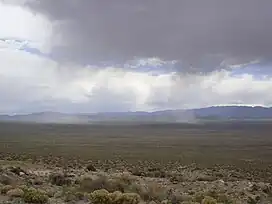Wah Wah Valley
Wah Wah Valley[1] is an endorheic (internal drainage) valley within the Basin and Range of west-central Utah, United States.
| Wah Wah Valley | |
|---|---|
 A spring storm hits the Wah Wah Valley, May 2009 | |
 Wah Wah Valley Location of the Wah Wah Valley within the State of Utah  Wah Wah Valley Wah Wah Valley (the United States) | |
| Floor elevation | 4,577 feet (1,395 m)[1] |
| Geography | |
| Location | Beaver and Millard counties, Utah, United States |
| Coordinates | 38°43′20″N 113°15′35″W [1] |
| Traversed by | State Route 21 |
Description
The valley is bound by the Wah Wah Mountains to the west and south and the San Francisco Mountains to the east. The northern part of the valley bifurcates around the southern end of the House Range, leading into Tule Valley to the northwest and the Sevier Desert-(Sevier Lake region), to the northeast.[2]
The 'Wah Wah' name comes from Wah Wah Springs, on the eastern slope of the Wah Wah Mountain range. 'Wah Wah' is reported to mean "good clear water".[3]
The lowest point in Beaver County is located just south of the Wah Wah Hardpan (dry lake), at the Millard County line.[4]
The valley is sparsely populated today, but it has had residents in the past, like in the ghost town of Newhouse. These people moved here for mining, but later, the region was used for grazing.
References
- "Wah Wah Valley". Geographic Names Information System. United States Geological Survey, United States Department of the Interior.
- "MyTopo Maps - Wah Wah Valley, Utah, USA" (Map). mytopo.com. Trimble Navigation, Ltd. Retrieved 16 Feb 2018.
- Van Cott, John W. (1990). Utah Place Names: A Comprehensive Guide to the Origins of Geographic Names: A Compilation. Salt Lake City: University of Utah Press. p. 387. ISBN 978-0-87480-345-7. OCLC 797284427. Retrieved 16 Feb 2018.
- Nash, Fred J., 2008, Utah's Low Points: A guide to the Lowest Points in Utah's 29 Counties, ISBN 978-0-87480-932-9